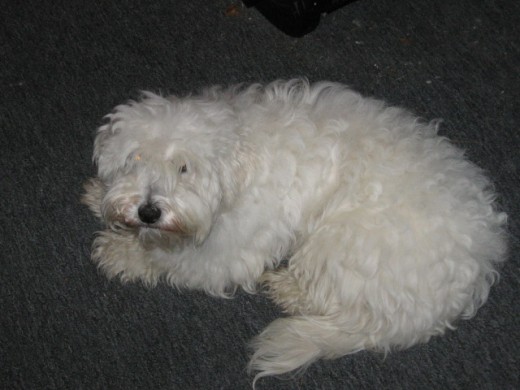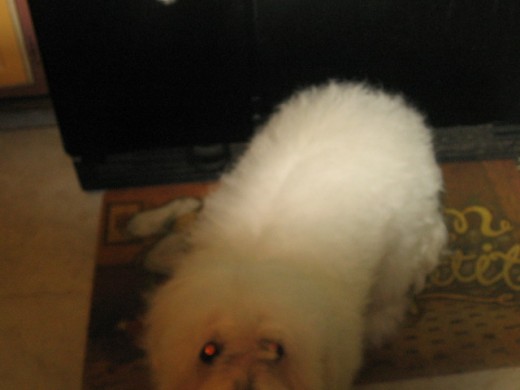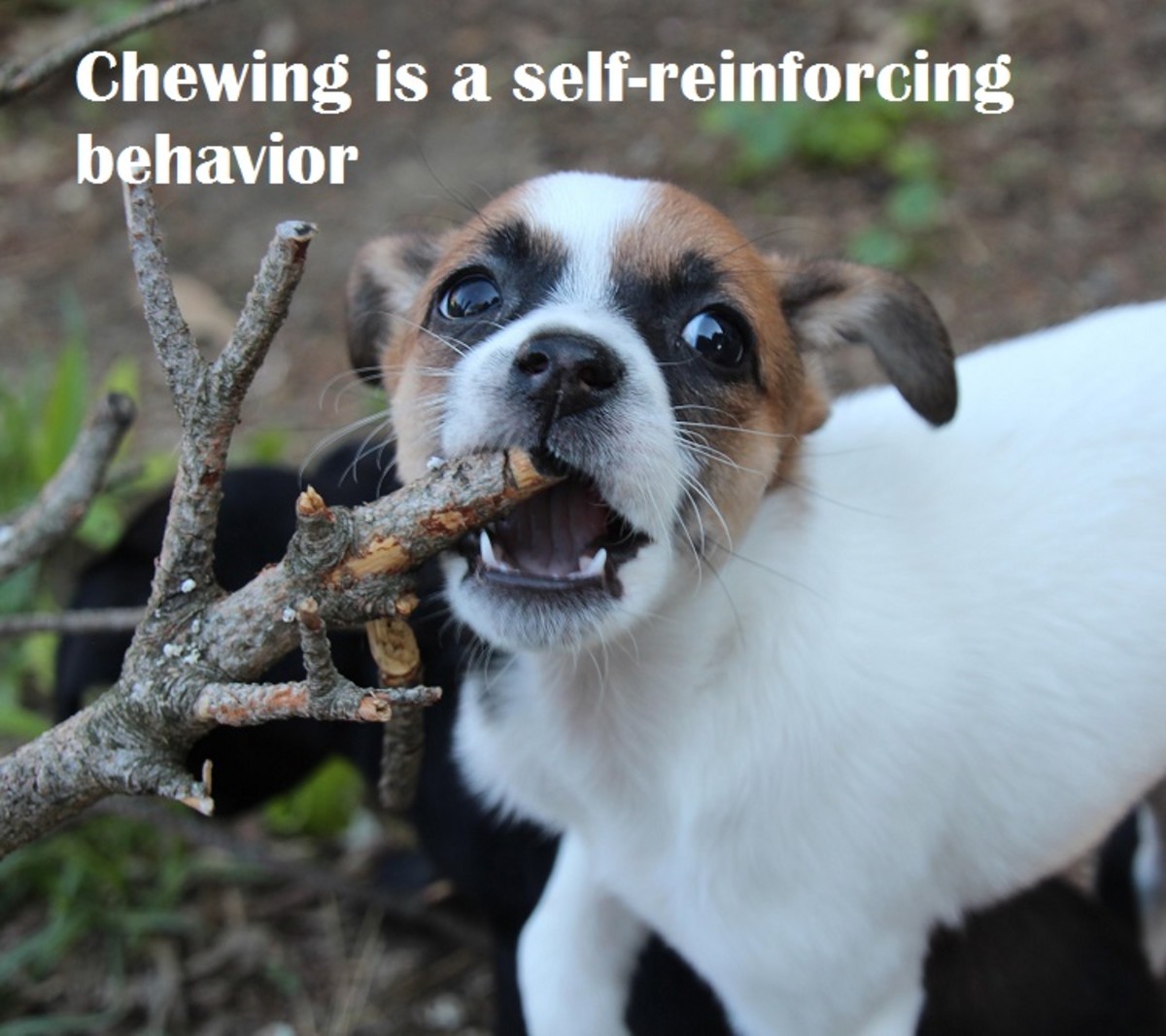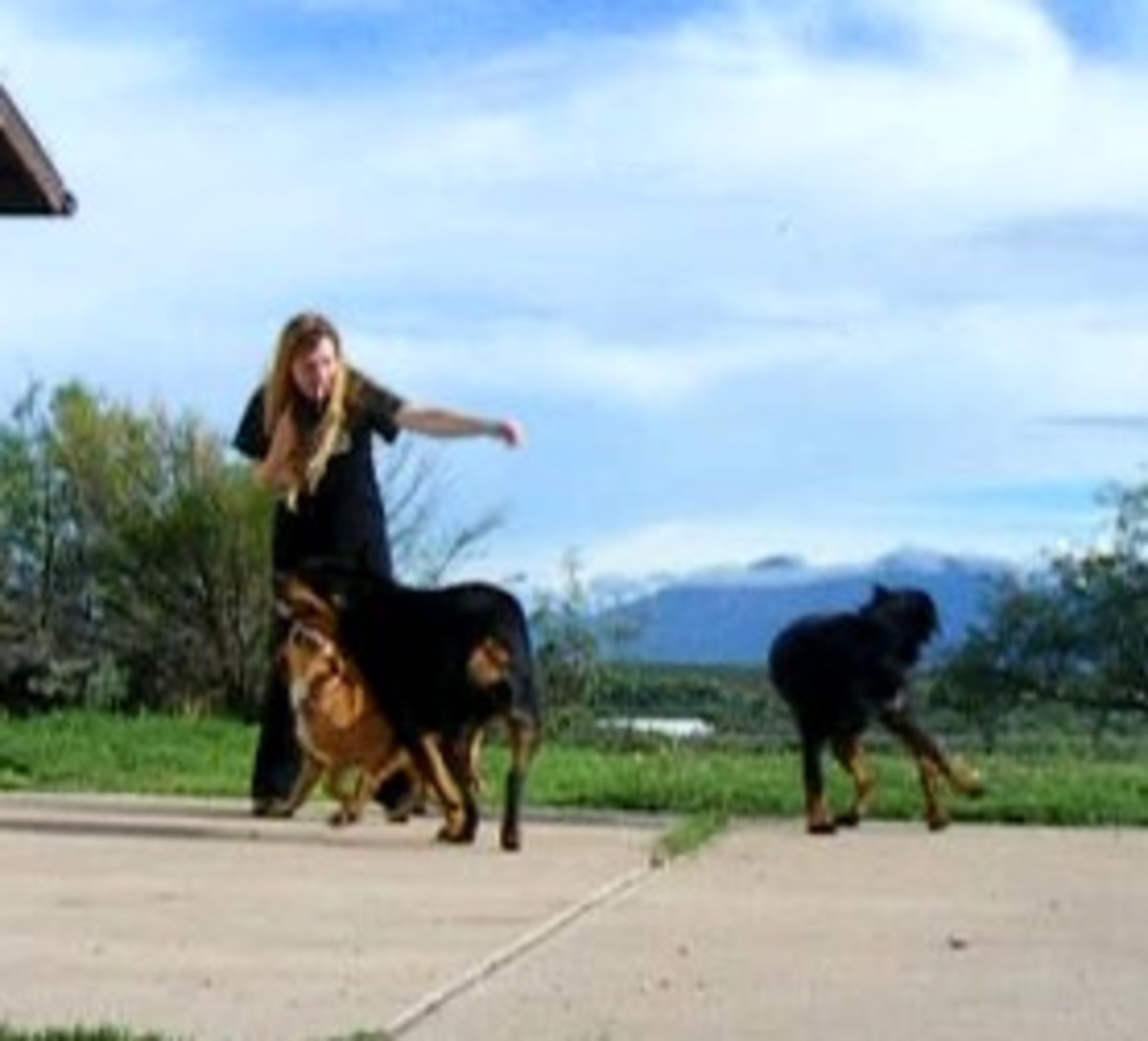Using Our Bodies to "Talk" to Our Dogs
Communication Continues
In EADT: Voulme 9 we took a look at how dogs communicate using body language and posture. Now it's time to turn around and look at the other side, namely, us humans.

Our Body Signals
We humans have postures that communicate to each other. We can cross our arms, put our hands on our hips, or shrug our shoulders. These all communicate things wordlessly to the person/people we are gesturing towards.
It works similar for dogs, though there's only some signals that really make sense to them. Some of them are postures while others are more overt actions. Many signals have to be learned by the dog because our body takes on forms that won't instinctively be understood. Fortunately, dogs are great observers so it's not as hard as it seems, but I'll only go over postures that seem to be universally understood as they are closest to what another dog might do.

Using Our Signals
Our body can send some strong signals. Many of these are almost like shouting as when a dog uses his body for communication, it's usually to deliver a strong, emphatic message. As such, we can usually halt action with our bodies.
Body Blocking
Body Blocking is the act of actually standing in the way of the dog, cutting him off from where he was going. This is a strong signal in the dog world and there's often no misunderstanding the intentions when we use it towards dogs as well. To execute body blocking, move as calmly, but firmly as possible and step directly in the way of the dog. If it is something on the ground, go ahead and step on it or right in front of it/or his nose.
As you might expect, this is a signal to stop. Now. Don't take another step. When I use this signal to Wally, he'll immediately look up at me and often will sit, a signal of his own (one signal is returned with another).
Body blocks can be used to enforce stays as well. Do it the same way, stand in his way. Do so quickly before he takes too many steps to make the most impact.
The Lean
Dogs don't usually lean over each other, but they can lean ON each other in an effort to get the target dog to move. Dogs can do this to us as well and it can mean the same thing (though, understand your dog before you assume). If one dog is taller than the other, then you can see this among dogs. Or if one dog is feeling confident, he can sort of "look down" on the other dog. While we can't really lean on a dog - we're too heavy most of the time and we end up just pushing the dog (and maybe us tripping over him) - we can lean over the dog.
This is best used when you have the dog's attention. For example, I often use it if Wally doesn't sit at an intersection. He'll look at me and if he's not sitting, I'll lean slightly over him. Another example is if he won't lie down when asked, I'll lean over him until he goes into a down, at which time I'll back off, letting him know I'm satisfied.
Kneeling/Lying Down
Not all postures are for communicating "dominance" or for controlling the dog's movements. Some are an invitation for fun or to approach. Dogs have the play bow and a wide wag of the tail and maybe a "Let's go!" happy growl or bark. The play bow is a tough position for use to duplicate, but we can kneel down closer to his height level. Many times, this will put a dog at ease as we are "giving away" our height advantage (height can equal power/control).
Another variation of this is going all the way to the ground and lying down. This is an even stronger signal to approach or that we have zero intention to exert any pressure on them. This is one that will get Wally going. He has promptly jumped up on my chest and started sniffing my face and licking my glasses (or my eye lids!). Sometimes, he'll instead sniff my ears and lick them, or my neck, or even my hair.
Body Language - A Dog's First Language
It's been shown that dogs understand body language faster than anything else. We can use this to our advantage for other things as well, such as teaching hand signals.
Remember luring? Well, luring works largely because of this and it creates a body movement the dog can associate with an action. It has the same effect as teaching him a new verbal cue or other auditory cue. Since dogs are "programmed" to watch what another creature's body is doing, from anything to social interaction to reading the movements of potential prey, to reading the movement of a possible predator/threat, body language is powerful and quickly noticed.
Try teaching or communicating via hand signals or other body cues. Try to teach your dog that hands on your hips means something. Or maybe cross your arms and connect that to a behavior, things like that. See what your dog's reaction is. He may offer a behavior, or keep watching and observing - he's trying to understand these new signals!
Be patient and encourage these communication attempts. It is the sign of a dog that's thinking and trying to use what you've taught him. If you don't want to interact, redirect him gently and calmly. That will communicate that you don't want to interact right now, but not shut him down from wanting to try again at a different time.
The Eyes and Face
Our eyes can't quite communicate as much since the whites of our eyes always show. Cutting them back and forth like a dog might may not communicate to the dog. However, we can stare like they can. Kind of. Another disadvantage to our eyes is that we have to blink a lot and have a harder time controlling our blinking.
Still, a good, hard stare can communicate paragraphs to your dog with a lot of bold print and exclamation points. Staring is something that is instinctively understood. It is also something that creates misunderstandings, especially when trying to teach your dog to, basically from his point of view, stare at you until told otherwise. Such a concept goes against everything the dog instinctively knows. He has to learn the context or read your energy to feel like it's "okay" to stare. If he's uncertain, you'll probably get a lot of look-aways or blinking (calming signals).
A hard stare is one where you have little expression on your face and lock directly on your dog's eyes and just stare. A lot of times, you'll at least get his attention (or you can make a sound or something to get him to look at you, then apply the stare) and he'll be fixed on you. Take the chance to redirect him to what you'd rather him do.
You can use your face expressions, although a lot of times our expression is more subconcious, just the product of our emotional state (much like the tail is to the dog). If you can connect an expression and consistently use it, go for it - the dog will get it.
Potential for Misunderstandings
Since body language is a powerful signal to dogs and we, sometimes unknowingly, communicate with our bodies as much as our words, dogs can get mixed messages and end up being confused as to what you're trying to say.
For example, if you say "good boy" but you're bending over him while looking in his eyes and right on top of him, he can get a misunderstanding of what you're trying to do. From his point of view, he's seeing a dominant/imposing posture and position, but your words and maybe your hands are providing a reward and positive energy. It can cause a conflict. Another one is calling for the dog to come while walking towards him and looking at him. Your command is for him to come to you, but your eyes and movement are saying "stay put". This might have him come, but do so while throwing calming signals at you and moving slowly (also a calming signal), or maybe not come at all and await a clearer signal.
It is important to not be too quick to punish in these situations. Misundertandings are not intentional refusals of commands and should not be treated as such. Be aware of the signals you just sent and give your canine more information and a clearer indication of what you want. His freezing or slow movement is his way of communicating "I don't know!" or "I'm confused, please don't be mad if I'm wrong."
Be patient and communicate and teach if needed. He does want to understand you. Just remember, we are speaking two different languages!
Wally's Communications
Dogs are of course more than a collection of "pre-made" signals and interpretations of other signals. They can take what they've learned and attempt to create more signals in an effort to communicate with you. When your dog offers you one of these created signals, your reactions will be key. The dog is trying to see what will happen and it can start the foundation of any future attempts, both of that signal and of attempting more proactive communication with you. Here, I'll share some of Wally's to give an idea of the things dogs might come up with.
Tapping me with his nose:
Wally will tap me with his nose when he's ready to start walking again. This usually happens when I'm just letting him roam to sniff and pee or just explore. When he's done and I don't quite "get" that he's done, he'll tap my leg with his nose before sitting down.
Standing on back legs then sitting:
Wally used to do this a lot while outside. He'll stand on his back legs and put his front paws on me for about a second, and then sit and stare at whatever is worrying him. I can then follow his eyes to see what he's looking at. It's like it's his way of saying "Hey, do you see that?"
Sitting directly in front of me:
He learned this one while teaching him the Front position. He took this position and uses it as his "I'm ready." position. The difference between this one and the nose tapping is that he's awaiting for the next thing we're doing. The nose tapping is used for continuing the walk. It seems the context is modifying the behavior he uses. I'm not certain why he utilzed this behavior.
Pawing/Sticking out his paw
This might be odd to put here because many dogs will paw naturally, but Wally never would until he learned the "shake" command. After that, he started doing this...A LOT. Sometimes he paws the air, sometimes he uses my leg as a scratching post, sometimes he'll paw the floor! He'll also stop walking if the leash wraps around his leg and hold that paw up (and it almost looks like has this embarassed look on face, though I know it's not embarrassment).




